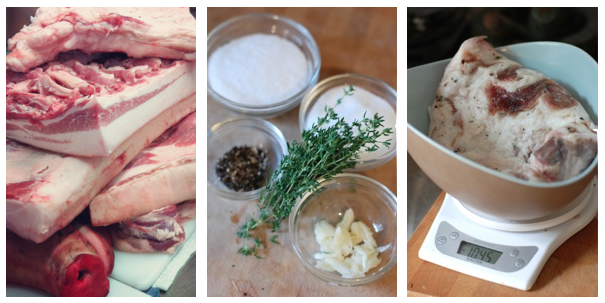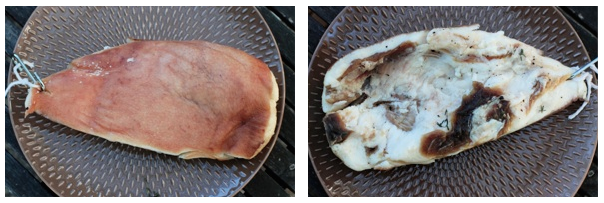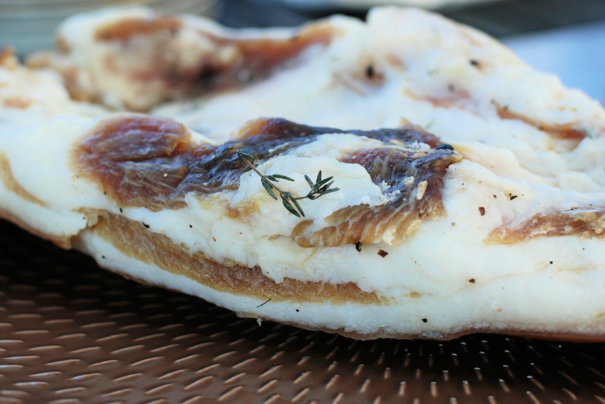Earlier this summer I had the pleasure of attending a Whole Hog Butchery class at Kitchen in the Market with local salumi-maker and chef Mike Phillips of Three Sons Meats in Minneapolis. We learned how to breakdown an entire hog for Italian salumi (cured meats), including dry sausage, coppa, hams, pancetta, lardo, etc. Little Foot Farms raised and supplied the pig, which was a rare heritage Gloucestershire Old Spots, an old British “lard” hog that’s know to carry more bacon fat than other breeds. Our hog at just 6 months old had a full 2 inches of back fat on him. After the we cut up the pig and made sausage, the class participants took home the unprocessed parts. I was lucky enough to get a pork jowl, from which I made the classic Italian Guanciale.
The big question in class was why use jowls for curing when you have these giant slabs of belly for bacon? The answer is that pork jowls have some special qualities. First off, they are loaded with fat from our lovely hog. Secondly, jowls have a cheek muscle in them that has worked extremely hard eating every day. It’s what pigs do, right? Hard working muscles equal good flavor. Pork belly muscled don’t work much (not that we don’t love them, too!)
The process for making guanciale is very simple for the home cook. I was inspired by many folks for this recipe, namely Michael Ruhlman, Hank Shaw & Matt Wright. My recipe differs from theirs in that I use more garlic and pepper, but otherwise, they are very similar. Check them out and decide which combo you’d like to use. The basics are that first you use a dry salt cure, then a moderately cool and humid air drying. It takes anywhere from 2 weeks to a month, depending on the size of the jowl and your curing environment. It goes without saying that for a product this primal you should use the best pork you can find. What it eats and how it lives will totally resonate in the taste. The resulting product is totally transformed into porky, fatty goodness with a distinctive flavor. The meat can be sliced thin and eaten raw, but traditionally, it is used in Italian pasta and polenta recipes, where it adds a luscious pork flavor that permeates the dish.
Since I finished my guanciale in the summer, I added my pork to a pot of sweet corn polenta. It was heaven! And even better in my lunch the second day. Below find my version of home-cured guanciale as well a recipe for sweet corn polenta with guanciale.

By Tammy Kimbler
Inspired by Michael Ruhlman, Hank Shaw & Matt Wright
Ingredients:
2 lb pork jowl
1/2 cup kosher salt
1/2 cup white sugar
4 cloves garlic, crushed
2 tsp black peppercorns, crushed
1 bunch fresh thyme
Instructions:
In a heavy duty plastic bag, combine all your ingredients. Shake and massage the ingredients around the jowl. Place it in the fridge for 4-7 days, turning the bag daily. The jowl will exude liquid and make its own brine. When the jowl is stiff after at least 4 days (depending on the thickness), remove from the bag and rinse well. Pat it dry.
Weigh the jowl. You want it to loose about 30% of it’s water during drying process, so it’s good to have a starting weight. Mine weighed 1045 grams, or 2.3 lbs after salting, making my finishing weight around 730 grams, or 2lbs. I kept the skin on my pork jowl, which can cause the process to take a bit longer. Cut a hole about an inch from the edge of the jowl and put a butcher’s hook or string through it. Hang the jowl in a cool place, preferably below 60 degrees for 2-4 weeks. I used my wine fridge with a pan of heavily salted water in the bottom for humidity. My jowl took 5 weeks to dry. Some people like to dry it even longer for a more robust flavor. Weigh your jowl every week to see how it’s doing. If it dries to quickly on the outside it may halt the drying process, so be sure you have a little humidity to slow things down.
When you think it’s done, cut off a little chunk, remove the skin and fry it crisp. The guanciale should have a good, savory, porky flavor. As you use the guanciale, save the skin for that pot of beans you’ve been meaning to make. Take off a hunk for the fridge and freeze the rest in a well wrapped package. And make my Sweet Corn Polenta with Guanciale before the summer is over!
By Tammy Kimbler
Ingredients:
6 ears fresh sweet corn
1/4 lb guanciale
1 onion
1 clove garlic
1 tbs fresh thyme leaves
4 tbs butter
salt & pepper
1/2 c grated parmesan cheese.
Instructions:
Cut the kernels off the corn, then scrape the cobs of their remaining juices and pulp. Put the corn in a food processors with 1/4 cup of water and finely blend. The processor will give you a rustic texture. Use a blender if you like it smoother. Finely dice your guanciale, onion and garlic. Melt the butter in a pan and add your guanciale. You want the guanciale to release it’s fat, but not to brown, so cook it on medium and stir often. When it’s translucent and rendered (5-10 minutes), add the onion and garlic and cook until soft. Add the thyme and blended corn. Bring to a simmer, then cook for about 20 minutes, stirring frequently. Just like regular polenta, this stuff sticks! When the corn is cooked and thicken, season to taste, then off the heat add the parmesan. This will not set up like dried polenta, but should softly hold it’s shape. Enjoy.



